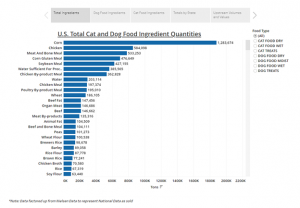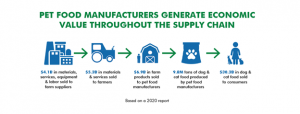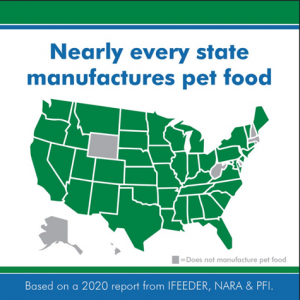The pet food trade uses over 19 billion pounds of animal and plant products every year. Dog and cat food includes more than 500 different agricultural products, many of these being “leftovers,” or byproducts, from the production of human food.

The production of food in the United States is one of the least wasteful industries I can think of. Almost everything that is left over after the production of one type of food can be used in other products.
For example, we commonly use brewer’s grains (from beer production), cotton seeds (from cotton production), citrus pulps (from juicing citrus), and trimmings from meat production to feed livestock or pets. The sales of these byproducts and other feed ingredients are critical for agricultural producers and manufacturers; they generate nearly $7 billion in economic value.

Pet food ingredients consist of many grain products, the number one being corn. Corn is a great filler and carrier ingredient to provide the necessary calories without compromising levels of protein, sugar, or other nutrients that can come from better sources.
The ingredient list on your pet food may contain products that say “meal” at the end, like chicken meal, beef meal, soybean meal, etc. These indicate byproducts from other industries. Meal from animal meat is usually composed of fat and meat trimmings when producing human food, whereas meal from plant products is usually leftovers from something like oil extraction (soybean meal).
Using the leftovers from food production helps reduce the environmental impact of agriculture, while also benefiting industries like pet food manufacturing. Instead of producing crops and animals specifically to feed our pets, we can utilize ingredients that would otherwise be going to the landfill as waste.
Learn more about ag and the pet food industry: Institute for Feed Education & Research report
Secondary sales of byproducts help agriculturalists make additional income on their products so they can keep product costs down for consumers and cheaper ingredients for pet food manufacturers help them keep final prices lower.
Forty-two of the 50 U.S. states produce pet food. Kansas, Iowa, Ohio, Pennsylvania, and Missouri reap the most economic benefits of the pet food trade. Of course, states with some of the highest populations consume the most pet food and therefore have the largest market (these states being Florida, Texas, and California).

Agriculture is truly the backbone of America. Nearly every industry requires some agricultural ingredient or byproduct, whether it is food based or not. It’s easy to forget just how much agriculture is intertwined into every aspect of our life and how efficient we have become in order to use every possible ingredient. The next time you scoop your dog’s dinner, remember to thank a farmer for the hard work they put in for man’s best friend!
Michelle Miller, the Farm Babe, is a farmer, public speaker and writer who has worked for years with row crops, beef cattle, and sheep. She believes education is key in bridging the gap between farmers and consumers.


